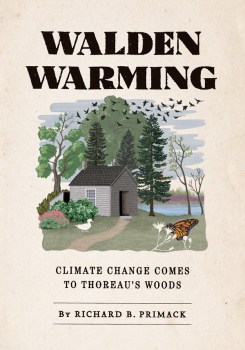Farewell to Ice Skating
An excerpt from “Walden Warming.”
The following is an excerpt from from Walden Warming: Climate Change Comes to Thoreau’s Woods, by Richard B. Primack.
In the 1840s, when Thoreau was living at Walden Pond, the idea of global warming did not yet exist, nor was there any reason for anyone to propose it. The farmers and townsfolk of nearby Concord, Massachusetts, were far more concerned with cold conditions. An early spring was a phenomenon people would have greeted with pleasure, as it meant relief from heavy snows and bone-chilling temperatures.
The mid-nineteenth century was a particularly cold period, deeply felt by a largely rural society. Frosts during the summer could kill the crops upon which farmers depended for food and income. A late frost on the night of June 12, 1846, killed the beans, tomatoes, squash, corn, and potatoes that Thoreau had planted in his field. Severe winter cold could also kill livestock in unheated barns as well as wild game, such as deer, that supplied supplemental meat. During an unusually cold winter, families might run out of firewood trying to heat their houses and would experience great hardship or freeze to death. In his journal, Thoreau wrote about the extraordinary cold weather of 1810, when he was three years old:
Mother remembers the Cold Friday very well. . . .The people in the kitchen . . .drew up close to the fire, but the dishes which the Hardy girl was washing froze as fast as she washed them, close to the fire. (Journal, January 11, 1857)
Had Thoreau been able to look into the future, I imagine he would have been dismayed by some of the changes that have occurred in Concord. In particular, the effects of climate change and rising temperature are now affecting his beloved Walden Pond. In New England, one place where global warming can be seen clearly is its lakes and ponds, now covered in winter with no more than a thin veneer of ice where before there was a thick ice covering.
The failure of thick ice to form on bodies of water is a phenomenon that has happened more frequently in recent decades. In the 1950s and early 1960s, when I was growing up in Newton, Massachusetts—a suburb of Boston not far from Concord—ice-skating was a popular pastime, with hundreds and even thousands of people gathering to ice-skate on Crystal Lake and Hammond Pond. I remember crowds of people gliding across the endless glassy-smooth lake surfaces, and then gathering around log fires to warm their frozen hands. A section of the lake was set aside for pickup games of hockey. In those years, winter temperatures were typically in the teens or single digits for weeks at a time, and the ice was very thick.

During the late 1980s and early 1990s, when I wanted to bring my own children ice-skating in such a natural setting, it was hard to find a suitable pond or lake in Newton. The winters were now too mild; without the long cold snaps of my boyhood, ice of sufficient thickness no longer formed. The thin ice brought risks of people falling through and drowning. The Newton city government moved to restrict skating at the traditional lakes and ponds, and urged people to use public skating rinks.
Many citizens, however, still longed for the natural experience of skating on a lake or pond. The city of Newton responded by designating two spots for ice-skating, Bullough’s Pond and Ware’s Cove on the Charles River. We enjoyed ice-skating trips to these places when our children were small. But after one or two seasons, the city had to abandon this plan. Too many winter days were above freezing, and the ice was just not thick enough to support safe skating.
In the autumn of 2011, a new fad hit the Boston area. Park department workers and parent volunteers built large wooden frames, 10 to 30 feet across, on open ground in town centers and playgrounds. While the frames resembled giant sandboxes, the actual plan was to flood the low frames with water during the freezing days of winter, creating a smooth ice-skating surface for children. However during the mild winter of 2011–12, daytime temperatures never consistently went below freezing. The skating rinks were never flooded and went unused.
Reprinted with permission from Walden Warming: Climate Change Comes to Thoreau’s Woods, by Richard B. Primack, published by the University of Chicago Press. © 2014 by The University of Chicago. All rights reserved.
Richard Primack is author of Walden Warming: Climate Change Comes to Thoreau’s Woods (University of Chicago Press, 2014) and a biology professor at Boston University in Boston, Massachusetts.